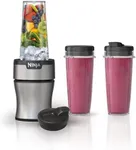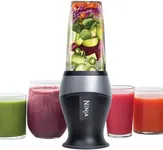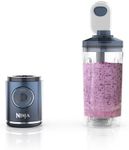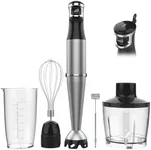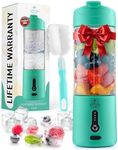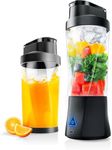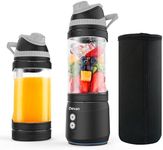Buying Guide for the Best Emulsifier Blenders
Choosing the right emulsifier blender can make a significant difference in the quality and efficiency of your blending tasks. Emulsifier blenders are specialized appliances designed to mix and emulsify ingredients, creating smooth and consistent textures. When selecting an emulsifier blender, it's important to consider several key specifications to ensure you get the best fit for your needs. Understanding these specs will help you make an informed decision and find a blender that meets your requirements.Power (Wattage)Power, measured in watts, indicates the strength of the blender's motor. This spec is important because a higher wattage means the blender can handle tougher ingredients and larger quantities more efficiently. Blenders typically range from 200 to 1500 watts. For light tasks like making dressings or smoothies, a blender with 200-500 watts may suffice. For more demanding tasks like crushing ice or blending thick mixtures, look for a blender with 600-1000 watts. If you frequently blend hard ingredients or large batches, consider a blender with 1000 watts or more.
Speed SettingsSpeed settings refer to the number of different speeds at which the blender can operate. This spec is important because it allows you to control the texture and consistency of your blends. Blenders can have anywhere from 2 to 10 or more speed settings. For basic blending tasks, 2-3 speeds may be sufficient. If you need more precision for tasks like emulsifying sauces or making nut butters, look for a blender with 5-10 speed settings. Choose a blender with variable speed control if you want maximum flexibility in your blending.
Blade DesignThe design and material of the blades affect the blender's performance and durability. This spec is important because high-quality blades ensure efficient blending and longer lifespan. Blades are typically made of stainless steel, which is durable and resistant to rust. Look for blenders with multi-pronged blades for better blending efficiency. If you plan to blend tough ingredients, choose a blender with strong, sharp blades. For general use, standard stainless steel blades should be sufficient.
Jar CapacityJar capacity refers to the volume of the blender's container, usually measured in liters or ounces. This spec is important because it determines how much you can blend at once. Blenders typically have jar capacities ranging from 0.5 to 2 liters. For single servings or small batches, a jar capacity of 0.5-1 liter may be adequate. For family-sized portions or larger batches, look for a jar capacity of 1.5-2 liters. Choose a capacity that matches your typical blending volume to avoid overfilling or multiple batches.
Material and Build QualityThe material and build quality of the blender affect its durability and ease of cleaning. This spec is important because a well-built blender will last longer and be easier to maintain. Blenders can be made from plastic, glass, or stainless steel. Plastic jars are lightweight and less prone to breaking, but may scratch over time. Glass jars are heavier and more durable, but can break if dropped. Stainless steel jars are very durable and resistant to stains, but you can't see the contents while blending. Choose a material that suits your preference for durability and ease of use.
Ease of CleaningEase of cleaning refers to how simple it is to clean the blender after use. This spec is important because a blender that is easy to clean will save you time and effort. Look for blenders with removable blades and dishwasher-safe parts for the easiest cleaning. Some blenders have self-cleaning functions, which can be very convenient. If you plan to use your blender frequently, choose one that is easy to disassemble and clean to ensure it remains hygienic and in good working condition.
